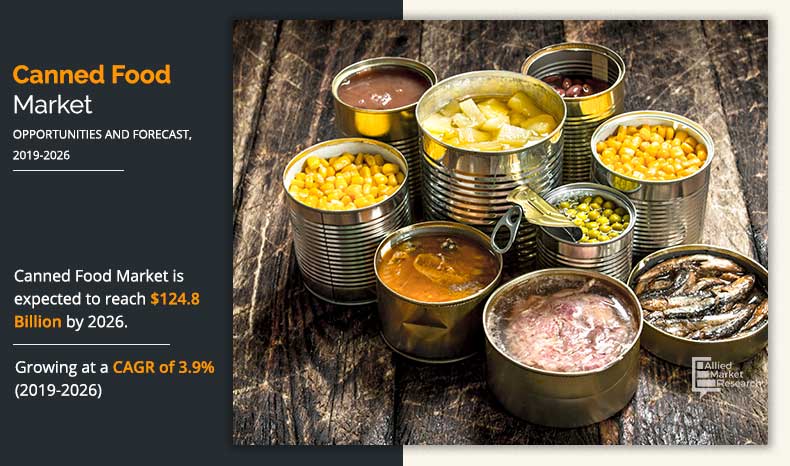According to a new report published by Allied Market Research, titled, “Canned food Market by Product Type, Distribution Channel, and Type: Global Opportunity Analysis and Industry Forecast, 2018–2026,” the global canned food market size was at $91.4 billion in 2018 and is anticipated to reach $124.8 billion by 2026, with a CAGR of 3.9% during the forecast period. The market is expected to exhibit an incremental revenue opportunity of $33.2 billion from 2018 to 2026. Fruits, vegetables, meals, seafood, meat, soups & sauces, beans, sweets & desserts, lentils, and pastas are the most popular canned foods preferred by consumers due to their taste, nutrition and/or convenience. Canned foods are the popular choice for breakfast, snack, and dessert among health-conscious consumers. Due to busy lifestyle, consumers have been shifting their preference toward the consumption of convenience food products. Owing to the high nutritional content in the canned food products and wide range of product types available, they have become one of the most preferred convenience food choices among consumers.
The canned food market growth is propelled by the rise in demand for convenience foods in the market. Busy lifestyle and increasing women workforce have contributed to consumer shift toward nutritional food products along with convenience, both offered by canned food products. Canning of food products retain high nutritional value such as proteins, fibers, minerals, and antioxidants. Furthermore, with the growing retail industry and rise in penetration of e-commerce, the reach of canned food products in emerging markets is likely to grow in the future.
Download Sample Copy of Canned Food Market Report @ https://www.alliedmarketresearch.com/request-sample/6304
The canned food market is segmented on the basis of product type, distribution channel, type, and region. On the basis of product type, it is categorized into canned meat & seafood, canned fruit & vegetables, canned ready meals, and others. Canned meat & seafood has been the most preferred choice of canned food among consumers due to their high protein content along with taste. The canned meat & seafood segment was valued at $40.3 billion in 2018 and is expected to grow with a CAGR of 3.2% from 2019 to 2026, to reach $52.2 billion by 2026. The canned ready meals segment is estimated to be the fastest growing segment during the forecast period.
On the basis of distribution channel, it is categorized into supermarket/hypermarket, convenience stores, e-commerce, and others. The supermarket/hypermarket segment led the canned food market, in terms of distribution channel, in 2018 and is estimated to grow with a CAGR of 3.2% during the forecast period. The segment is expected to reach $54.8 billion by 2026. The e-commerce segment is anticipated to be the fastest growing segment during the canned food market forecast. Rise in penetration of smartphones and growing number of consumers seeking convenience in their lifestyle is likely to drive the e-commerce distribution channel segment in the canned food market.
Get detailed COVID-19 impact analysis on the Canned Food Market @ https://www.alliedmarketresearch.com/request-for-customization/6304?reqfor=covid
On the basis of type, the conventional segment held a significant share in the global market in 2018. However, the organic segment is expected to grow at a higher CAGR, owing to increase in inclination of consumers toward organic food products. In addition, growing awareness about the hazards of synthetic chemicals on health among consumers is further likely to contribute to its market attractiveness.
On the basis of region, the canned food industry is analyzed across North America (the U.S., Canada, and Mexico), Europe (Germany, France, the UK, Italy, Spain, and Rest of Europe), Asia-Pacific (China, Japan, Australia, India, and Rest of Asia-Pacific), and LAMEA (Latin America, the Middle East, and Africa). Europe led the market for canned food globally. This can be attributed to high per capita consumption of canned food products in majority of the European countries including Germany, the UK, Italy, France, and Spain. Consumers in the region are attracted by new flavors and types of canned food products, which has led to the growth of the market in this region. Furthermore, the market in Asia-Pacific is expected to witness the highest CAGR, owing to the expansion of the retail industry and rising disposable income of consumers.
For Purchase Enquire: https://www.alliedmarketresearch.com/purchase-enquiry/6304
Key findings of the Study:
The canned food market was valued at $ 91.4 billion in 2018 and is estimated to reach $124.8 billion by 2026, growing at a CAGR of 3.9% during the forecast period.
By type, the organic segment is estimated to witness the fastest growth, registering a CAGR of 6.4% during the forecast period.
In 2018, by distribution channel, the supermarket/hypermarket segment held the highest share, accounting for one third of the global canned food market share.
In 2018, Germany was the most prominent market in the Europe region and is expected to grow at a significant CAGR throughout the forecast period.
The key players profiled in this report include Del Monte Foods, Conagra Brands, Kraft Heinz, Nestlé, Campbell Soup Company, JBS, CHB Group, AYAM, Danish Crown, and Bolton Group.
Similar Reports:
Global Infant Nutrition Market Expected to Reach $61.6 Billion by 2026
Global Free from Food Market Expected to Reach $161.2 Billion by 2026
About Us:
Allied Market Research, a market research and advisory company of Allied Analytics LLP, provides business insights and market research reports to large as well as small- & medium-scale enterprises. The company assists its clients to strategize business policies and achieve sustainable growth in their respective market domain.
Allied Market Research provides a one-stop solution right from data collection to investment advice. The analysts at Allied Market Research dig out factors that help clients understand the significance and impact of market dynamics. The company applies the client’s insight on the factors such as strategies, future estimations, growth or fall forecasting, opportunity analysis, and consumer surveys among others. As follows, the company offers consistent business intelligence support to help clients transform into a prominent business firm.
